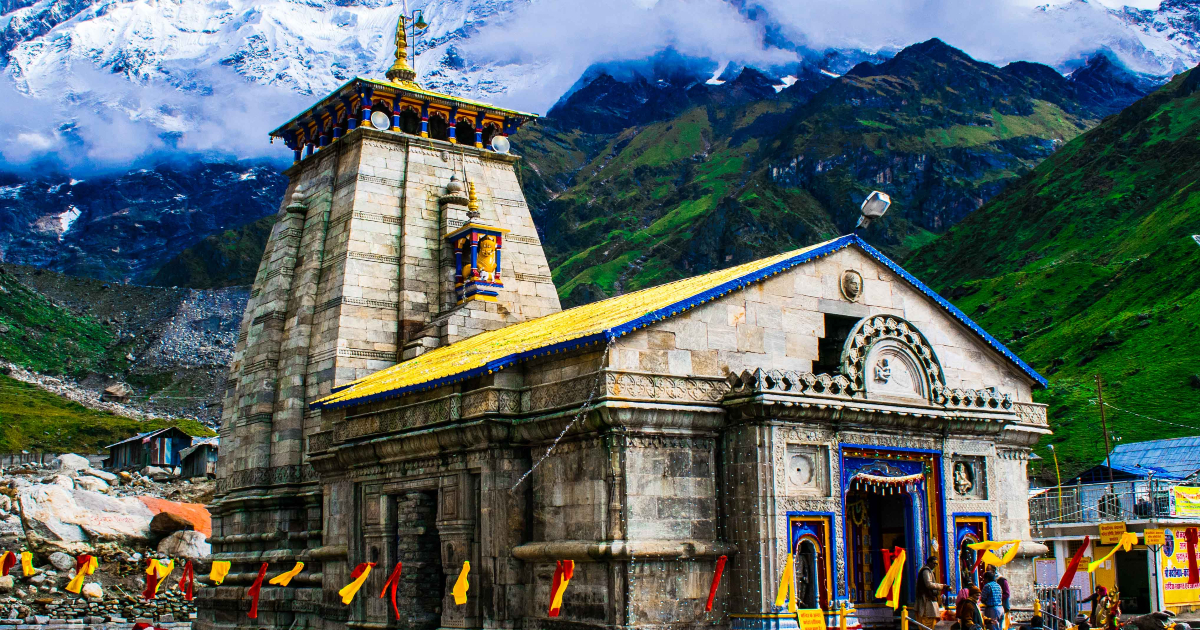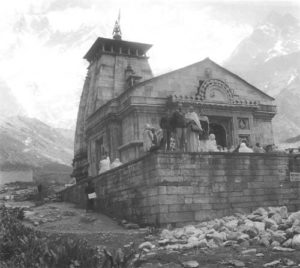The Kedarnath Temple
Hello Everyone My Name is Vivek Chaturvedi. I am write a blog about The Kedarnath Temple.
Kedarnath Temple is a Hindu temple (shrine) dedicated to Shiva. Located on the Garhwal Himalayan range near the Mandakini river, Kedarnath is located in the state of Uttarakhand, India. Due to extreme weather conditions, the temple is open to the general public only between the months of April (Akshaya Tritiya) and November (Kartik Purnima, the autumn full moon). During the winters, the vigraha (deity) from Kedarnath temple is carried down to Ukhimath and where the deity is worshiped for the next six months. Kedarnath is seen as a homogenous form of Shiva, the 'Lord of Kedarkhand', the historical name of the region.
The temple is not directly accessible by road and has to be reached by a 22 kilometres (14 mi) uphill trek from Gaurikund. Pony and manchan service is available to reach the structure. According to Hindu legends, the temple was initially built by Pandavas, and is one of the twelve Jyotirlingas, the holiest Hindu shrines of Shiva. Pandavas were supposed to have pleased Shiva by doing penance in Kedarnath. The temple is one of the four major sites in India's Chota Char Dham pilgrimage of Northern Himalayas. This temple is the highest among the 12
Jyotirlingas. Kedarnath was the worst affected area during the 2013 flash floods in North India. The temple complex, surrounding areas, and Kedarnath town suffered extensive damage, but the temple structure did not suffer any "major" damage, apart from a few cracks on one side of the four walls which was caused by the flowing debris from the higher mountains. A large rock among the debris acted as a barrier, protecting the temple from the flood. The surrounding premises and other buildings in the market area were heavily damaged.
It is one of the 275 Paadal Petra Sthalams, expounded in Tevaram, a sacred Tamil Shaivite text written during 6th and 7th century by various saints called Nayanars. This temple is sung by Thirugnanasambandar and Sundarar in their Tevaram texts.
Five Temples
The head priest (Raval) of the Kedarnath temple belongs to the Veerashaiva community from Karnataka. However, unlike in Badrinath temple, the Raval of Kedarnath temple does not perform the pujas. The pujas are carried out by Raval's assistants on his instructions. The Raval moves with the deity to Ukhimath during the winter season. There are five main priests for the temple, and they become head priests for one year by rotation. The present (2013) Raval of Kedarnath temple is Shri Vageesha Lingacharya. Shri Vageesh Lingacharya who belongs to the Village Banuvalli of Taluka Harihar of Davanagere district in Karnataka. A triangular shaped lingam is worshiped in Garbhagriha of the temple. Surrounding Kedarnath, there are many symbols of the Pandavas. Raja Pandu died at Pandukeshwar. The tribals here perform a dance called "Pandav Lila". The mountain top where the Pandavas went to Swarga, is known as "Swargarohini", which is located off Badrinath. When Yudhishtira, the eldest of the Pandavas, was leaving for the heaven, one of his fingers fell on the earth. At that place, Yudhishtira installed a Shiva Linga, which is the size of the thumb. To gain Mashisharupa, Lord Shiva and Bheema fought with maces. Bheema was struck with remorse. He started to massage Shiva's body with ghee. In memory of this event, even today, this triangular Shiva lingam is massaged with ghee. Water and bilva-patra leaves are used for worship.
Administration
Jyotirlinga
History
The temple, at a height of 3,583 m (11,755 ft), 223 km (139 mi) from Rishikesh, on the shores of Mandakini river, a tributary of Ganga, is a stone edifice of unknown date. It is not certain who built the original Kedarnath temple and when. The name "Kedarnath" means "the lord of the field": it derives from the Sanskrit words kedara ("field") and natha ("lord"). The text Kashi Kedara Mahatmya states that it is so called because "the crop of liberation" grows here.
According to a theological account, the god Shiva agreed to dwell here at the request of Nara-Narayana. After the Kurukshetra War, the Pandava brothers, came here to meet Shiva on the advice of the sage Vyasa, because they wanted to seek forgiveness for killing their kin during the war. However, Shiva did not want to forgive them: so, he turned into a bull and hid among the cattle on the hill. When the Pandavas managed to track him, he tried to disappear by sinking himself head-first into the ground. One of the brothers, Bhima, grabbed his tail, forcing him to appear before them and forgive them. The Pandava brothers then built the first temple at Kedarnath. The portions of Shiva's body later appeared at four other locations; and collectively, these five places came to be known as the five Kedaras ("Panch Kedar"); the head of the bull appeared at the location of Pashupatinath.
The Mahabharata, which gives the account of the Pandavas and the Kurukshetra War, does not mention any place called Kedarnath. One of the earliest references to Kedarnath occurs in the Skanda Purana (c. 7th-8th century), which contains a story describing the origin of the Ganges river. The text names Kedara (Kedarnath) as the place where Shiva released the holy water from his matted hair.
According to the hagiographies based on Madhava's Sankshepa-shankara-vijaya, the 8th century philosopher Adi Shankara died at Kedaranatha (Kedarnath); although other hagiographies, based on Anandagiri's Prachina-Shankara-Vijaya, state that he died at Kanchi. The ruins of a monument marking the purported death place of Shankara are located at Kedarnath. Kedarnath was definitely a prominent pilgrimage centre by the 12th century, when it is mentioned in Kritya-kalpataru written by the Gahadavala minister Bhatta Lakshmidhara.
According to a tradition recorded by the English mountaineer Eric Shipton (1926), "many hundreds of years ago", the Kedarnath temple did not have a local priest: the priest of the Badrinath temple used to hold services at both the temples, travelling between the two places daily.
2013 Kedarnath disaster
The Kedarnath valley, along with other parts of the state of Uttarakhand, was hit with unprecedented flash floods on 16 and 17 June 2013. On 16 June, at about 7:30 p.m. a landslide and mudslides occurred near Kedarnath Temple with loud peals of thunder. An enormously loud peal was heard and huge amounts of water started gushing from Chorabari Tal or Gandhi Tal down Mandakini river at about 8:30 p.m. washing everything away in its path. On 17 June 2013 at about 6:40 a.m. in the morning waters again started cascading at a huge speed from river Swaraswati and Chorabari Tal or Gandhi Tal bringing along with its flow huge amount of silt, rocks, and boulders. A huge rock got stuck behind Kedarnath Temple and protected it from the ravages of the flood. The waters gushed on both the sides of the temple destroying everything in their path. Even eyewitness observed that one large rock got carried to the rear side of Kedarnath Temple, thus causing obstruction to the debris, diverting the flow of river and debris to the sides of the temple avoiding damage.
Another theory for the temple not being destroyed is because of its construction. Although the temple withstood the severity of the floods, the complex and surrounding area were destroyed, resulting in the death of hundreds of pilgrims and locals. Shops and hotels in Kedarnath were destroyed and all roads were broken. People took shelter inside the temple for several hours, until the Indian Army airlifted them to safer places. The Uttarakhand Chief Minister announced that the Kedarnath shrine would remain closed for a year for clearing the debris.
The experts, who were asked by the Archaeological Survey of India to examine the condition of the foundation in wake of the floods have arrived at the conclusion that there was no danger to the temple. The IIT Madras experts visited the temple thrice for the purpose. Non-destructive testing instruments that do not disturb the structure of the temple were used by the IIT-team for assessing the health of the structure, foundation, and walls. They have submitted their interim report that the temple is stable and there was no major danger.
Nehru Institute of Mountaineering (NIM) was given the responsibility of Rebuilding Kedarnath. Although the institute did not have the expertise in urban planning or construction, they mastered in high altitude training. Under the leadership of veteran mountaineer, Colonel Ajay Kothiyal, NIM rigorously worked for a year and made the pilgrimage yatra possible from the next year.
After lockdown please go one time in your life Kedarnath Temple.
Thanks for Reading. Please comment me are you like my blog. Please share with your family members and friends.





Comments